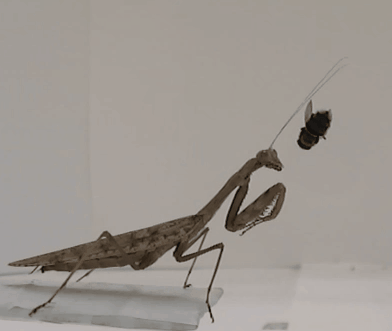Submitted by Rachel Aucott on Wed, 13/05/2020 - 15:09
Most predators must be flexible to capture prey trying to evade them, but ambush predators are often thought to have a stereotyped behaviour.
One such predator is the praying mantid who ambush their prey with raptorial strikes, often snatching them from mid-air. In a new paper published today in Biology Letters, Sergio Rossoni, a PhD student in the Department and Professor Jeremy Niven at the University of Sussex have challenged the assumption that they simply sit and wait for their prey. They have discovered that praying mantids can adjust the duration of their strike to the speed of their prey they are hunting, and even pause to wait for slow prey. They did this by presenting mantids with small beads held on a wire that could be moved at different speeds, which they then filmed and analysed the results. The results showed that visually-guided adjustment allows the mantids to time the strike to the approaching prey.
Professor Jeremy Niven completed his PhD in locust limb control at the Department of Zoology, University of Cambridge, UK and is now based in the School of Life Sciences at the University of Sussex. Sergio Rossoni graduated from the University of Sussex with a BSc in Neuroscience and Cognitive Science and an MRes in Neuroscience before moving to the University of Cambridge to start a PhD on the behaviour and neuroscience of fast invertebrate predators at the Department of Zoology.
Sergio Rossoni and Jeremy E. Niven. 2020. Prey speed influences the speed and structure of the raptorial strike of a ‘sit-and-wait’ predator. Biol. Lett.1620200098. DOI: https://doi.org/10.1098/rsbl.2020.0098
Image by Dylan Scott

